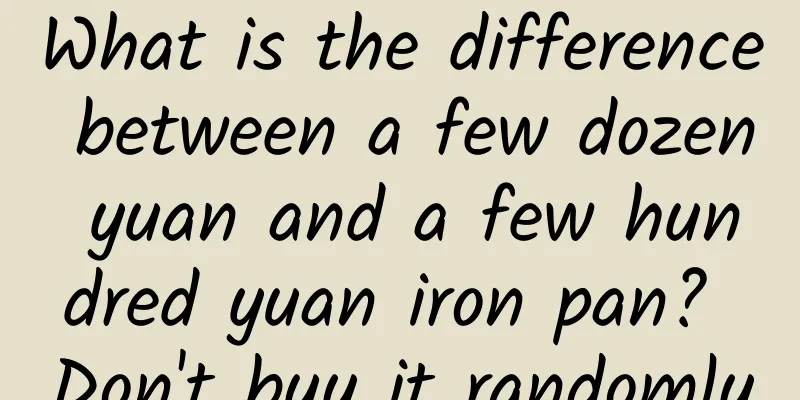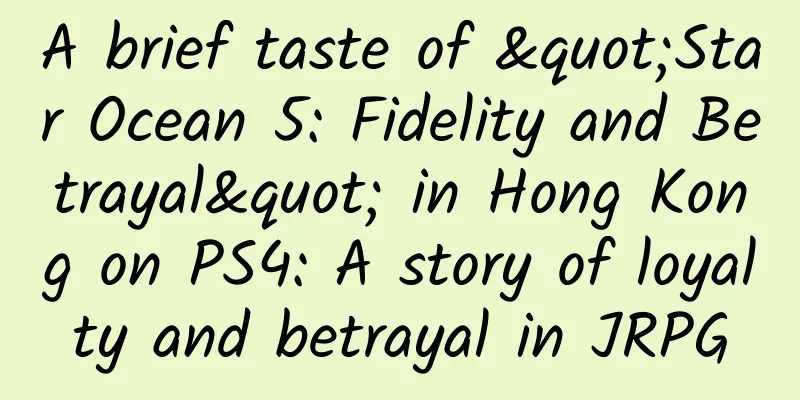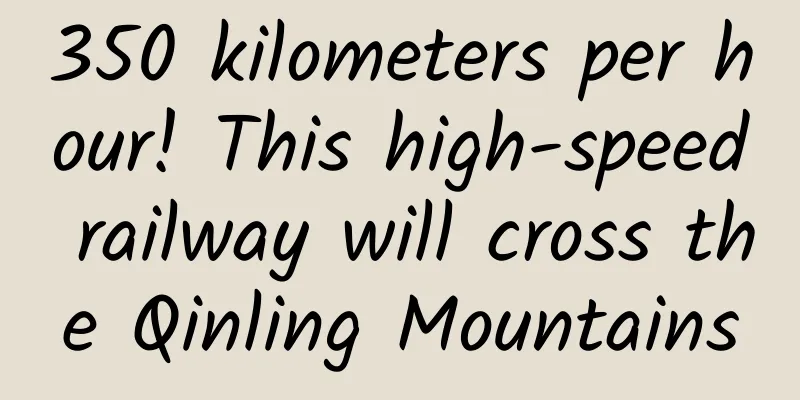What is the difference between a few dozen yuan and a few hundred yuan iron pan? Don't buy it randomly

|
In recent years, iron pans seem to be making a comeback, and a quick search on the Internet will reveal all kinds of benefits of iron pans, such as "iron pans can replenish iron when cooking" and "iron pans do not need chemical coatings to prevent sticking, making them safer to use." There are also people who highly praise cast iron pans, saying that "in the past, a cast iron pan could be used for decades, but nowadays, pans are no longer usable after a few years, so cast iron pans are the only choice." But a quick search online shows that iron pans are divided into cast iron pans, pig iron pans, wrought iron pans, and fine iron pans. The prices also vary, ranging from a dozen yuan to several hundred yuan or even several thousand yuan. So, what are the differences between these iron pans? Are more expensive iron pans really better than cheaper ones? The picture is taken from the Internet The price of iron pan is not the more expensive the better Raw materials and technology are the main factors affecting prices Let me give you the answer first: There are two main types of iron pans on the market, cast iron pans and wrought iron pans, and there is no absolute good or bad in these two types of pans. The prices of different iron pans vary, mainly due to differences in production processes, brands, and cultural factors . Cast iron pots use iron with a relatively high carbon content (i.e. pig iron). Such iron pots are often cast by pouring molten iron directly into a mold. The heavy pots used on many rural stoves are cast iron pots. Wrought iron is iron with a relatively low carbon content. Because this kind of iron needs to be forged from pig iron in ancient times, it is also called wrought iron or forged iron. Refined iron also belongs to wrought iron. The common Zhangqiu iron pot belongs to this category. Copyright images in the gallery. Reprinting and using them may lead to copyright disputes. In fact, if you only look at the prices of these two types of pots, you will find that there is no absolute difference between cast iron pots and wrought iron pots. Because there is really no absolute good or bad between them. For example, a cast iron pan is thicker and heavier, so it takes longer to heat up, but it also cools more slowly than a wrought iron pan, so it has better heat retention. Wrought iron pans are generally thinner and lighter than cast iron pans, heat up faster, and are more suitable for stir-frying. It is also easier to flip a spoon in a wrought iron pan than in a cast iron pan. However, there may be some differences within the same iron pan. For example, the raw materials used in the casting, the casting process, and whether the manufacturer has used the pan in advance will affect the price of the cast iron pan. In addition, the cast iron pan industry recommended specifications (QB/T 3648-1999) also mention the requirements for cast iron pans' heat preservation, impact resistance, and explosion resistance. However, because it is a recommended specification, not all cast iron pans will comply with it, so you can also refer to it when purchasing. It should be noted that because the raw materials of cast iron may contain more impurities, when purchasing a cast iron pot, be sure to check whether it has a quality inspection certificate to ensure health. The same is true for wrought iron pots. The raw materials used in forging the iron pot, the forging process, and whether the pot is finally blued or otherwise treated will all affect the price of the pot. Although the price of a pot will be affected by many factors, you should be careful if some iron pots are sold at high prices under the following two names. 1. Iron pots really don’t add iron Don't waste money on iron supplements When it comes to iron pans, many people's first reaction is "cooking with an iron pan can supplement iron." But in fact, the iron supplement effect of iron pans is minimal, because not all types of iron can be effectively absorbed by the human body. There are many types of iron in the food we eat every day and in iron supplements, but they can be roughly divided into two categories: heme iron and non-heme iron. Iron-containing hemoglobin, Image source: Wikipedia Our absorption rate of heme iron is relatively high, reaching 15% to 35%. The iron in duck blood, pig blood, red meat, and animal liver is mainly this type. The absorption rate of non-heme iron is relatively low. For example, the main ingredient of some iron supplements is ferrous sulfate, which is non-heme iron, and the absorption rate is only 5% to 10%. Many people think that red dates and spinach can supplement iron, but the iron in them is also non-heme iron, so their iron supplementation effect is not as good as animal blood. The iron scraped from the wok is either iron powder or trivalent iron produced by oxidation of the wok surface with air. The absorption rate of these irons is very low. For example, someone has studied the absorption rate of iron powder by the human body, which is only about 1.8% to 3.6% (36% of ferrous sulfate). Therefore, using an iron wok to supplement iron will have a very poor effect. This is actually very abstract. Let's use our imagination to do some calculation. If we really use iron pots to replenish iron, how many iron pots will we eat in a year? According to the Dietary Nutrition Guidelines for Chinese Residents (2016) and the Dietary Nutrient Reference Intakes for Chinese Residents (Part 3: Trace Elements) (WS/T 578.3-2017), the recommended daily iron intake for adult males is 12 mg and for females is 20 mg. The recommended iron intake for children varies by age and gender, but we can estimate that a family of three needs 45 mg of iron supplementation per day. If calculated based on a 3% absorption rate, about 1500 mg (1.5 g) of iron pan would be needed every day to meet the demand. In a year, about 547 g of iron pan would be needed. That is to say, the weight of the iron pan should be reduced by more than 1 catties every year. If the iron pan only provides half of the daily iron requirement, it will lose half a kg in a year. In addition, the heme iron content in the meat we usually eat is not low, so eating meat on a daily basis can also meet our basic needs. Therefore, it is not very reliable to rely on iron pots to replenish iron. If there are iron pots sold at high prices in this name, you should be more careful. Instead of spending hundreds or thousands of yuan to buy a "iron-replenishing iron pot", it is better to eat more foods such as duck blood, pig liver, and clams. Copyright images in the gallery. Reprinting and using them may lead to copyright disputes. 2. Iron pans can also prevent sticking without chemical coating Don’t be fooled by the “physical anti-stick” gimmick In addition, when promoting iron pans, many businesses will mention that their iron pans "are anti-stick without chemical coating, so they are better than other pans." In fact, the ability to prevent sticking without chemical coating is a common feature of all iron pans and stainless steel pans, and is not unique to a certain type of iron pan. To make this clear, let's first talk about why food sticks to the pan. When we heat food at high temperatures, the proteins and sugars in the food will undergo a series of changes, and the sugar and protein molecules may be destroyed. The protein and sugars close to the pot may form some chemical bonds with the surface of the pot, which is what we often call "sticking to the pot". To prevent sticking, you need to prevent the formation of chemical bonds between the pan and the food. 1 The principle of non-stick pan Non-stick pans with anti-stick coating use a material called polytetrafluoroethylene (Teflon). The chemical bonds of this material itself are very "strong" and it is not easy to form new chemical bonds with the protein and sugar molecules in food, so it can prevent sticking. But PTFE also has some disadvantages. For example, it will start to deteriorate after being heated to 260 degrees Celsius. In most cases, people will not reach such high temperatures when cooking soup or frying vegetables. But in some special cases, such as when the water in the pot is boiled dry, or the pot is heated for too long without adding oil, the temperature of the pot surface may exceed 260 degrees Celsius. In addition, if you repeatedly scrape the pot with a spatula when cooking, or use a steel wool when washing the pot, it may damage the surface of the polytetrafluoroethylene coating and make the non-stick pan ineffective. 2 Iron pan can also prevent sticking Of course, chemical coatings are not the only ones that can prevent sticking. For example, we usually put some oil in the pan before frying. Oil can also reduce the formation of chemical bonds between food and the pan. In addition, shaking the pan more when frying food and turning the food over can also reduce the chance of chemical bonds forming. In addition, some iron pans are made through a process called blueing. Blueing is actually to form a dense layer of ferroferric oxide film on the surface of the pan. This film can also play a similar role as a non-stick pan coating, but it requires oil to form an oil film to assist. 3 Leidenfrost effect There is another point that needs to be explained. Some merchants may claim that their iron pans do not require any coating or oil to be anti-stick. The basis behind this is actually a physical principle called the Leidenfrost effect. The Leidenfrost effect states that when a liquid comes into contact with an object whose temperature is much higher than its boiling point, a thin film will form between the liquid and the surface of the object. For example, when water drops onto the surface of a very hot pot, the area in contact with the pot will quickly boil and evaporate, forming an "air cushion" separating the water drop from the pot. There will be a gap between the water and the surface of the pot. Image source: Wikipedia Using the Leidenfrost effect, any pan can be made non-stick. For example, when frying eggs, you only need to heat the pan first, and let the temperature of the pan be much higher than the boiling point of water (for example, reaching 200 degrees Celsius), and then beat the eggs. Once the water in the eggs touches the bottom of the pan, the Leidenfrost effect will occur, and an "air cushion" will be generated between the eggs and the bottom of the pan. Using this principle, it is indeed possible to achieve non-stick. But it should be noted that this is not a unique feature of iron pans. All types of pans, including aluminum pans, stainless steel pans, and non-stick pans can achieve this. Moreover, when frying fish or meat, the Leidenfrost effect may fail because the "air film" created by water vapor may not be able to support the food, and the food will still stick to the pan. Therefore, iron pans can indeed achieve non-stick properties without coating, but the physical anti-stick properties of iron pans still need to be used in conjunction with oil. In short, there may indeed be differences in production techniques between iron pans that cost tens of yuan and those that cost hundreds of yuan, and there are also some brand and cultural blessings, such as "intangible cultural heritage iron pans". As long as it is within your affordability, there is nothing wrong with buying a good-looking, handmade iron pan, but don't be fooled by gimmicks such as "good iron supplement effect" and "physical anti-sticking". References [1]Ems T, St Lucia K, Huecker M R. Biochemistry, iron absorption[J]. 2017. [2]Hoppe M, Hulthén L, Hallberg L. The relative bioavailability in humans of elemental iron powders for use in food fortification[J]. European Journal of Nutrition, 2006, 45: 37-44. [3] Dietary Nutrition Guidelines for Chinese Residents (2016) [4] “Dietary Reference Intakes of Nutrients for Chinese Residents (Part 3: Trace Elements)” (WS/T 578.3—2017) [5]https://edu.rsc.org/download?ac=12362 [6]https://www.newscientist.com/article/2266479-physicists-finally-figured-out-why-food-sticks-to-a-frying-pan/ Planning and production Author: Xiaowei Popular Science Creator Review丨Ji YangResearcher at the Institute of Semiconductors, Chinese Academy of Sciences Planning丨Zhong Yanping Editor: Zhong Yanping Proofread by Xu Lailinlin |
<<: His appearance from more than 1,400 years ago has been restored!
>>: The battery is running low again! Is there any cure for your battery anxiety?
Recommend
For the first time, humans have detected the atmospheric composition of an Earth-like planet outside the solar system. Will it become our new home?
Recently, astronomers used the James Webb Space T...
There are frequent layoffs in the industry. Is the Internet bubble about to burst?
2016 is coming to an end. When the first day of D...
What impact will the major App Store revision have on Apple’s ecosystem?
At the WWDC 2017, which lasted more than two hour...
Chen Binbo was transferred to Dongfeng after his success, and Zheng Chunkai took over as the deputy general manager of Dongfeng Honda
"I am officially leaving Dongfeng Honda toda...
GDC 2015: The secrets of Chinese mobile game social operations
Recently, KTplay, as China's largest mobile g...
China Automobile Dealers Association: China's auto dealer inventory warning index is 58.2% in December 2022
The latest "China Automobile Dealer Inventor...
Huawei responds to US ban on Chinese 5G: Restricting Huawei will not make the US stronger
[[265442]] The US blockade of China's 5G tech...
Is the mosquito repellent song that is popular on the Internet really effective?
Summer is here, and it’s time to “fight mosquitoe...
Hey, are you ready to welcome the little cutie~ The baby koala is born!
I guess everyone already knows it~ Our little Liu...
What exactly is the human hemipulmonary virus that has become a hot topic, and how can we deal with it?
Recently, the topic #国产发生人体块病毒菌# suddenly became ...
After reading the font series of articles, do you still think I am talking about fonts?
[[208286]] Recently, I have been writing a series...
Will humans achieve active evolution and become one with machines? He is the world's first cyborg
Since the first single-cell life appeared on Eart...
Evolution and disruptive innovation of the 5G private network market: Q1 2022
Participants take partnerships and strategy more ...
The equivalent of the Earth's 12-year hot and cold cycle! Who "directed" Jupiter's magical "mirror climate"?
40 years of research confirms Jupiter's anoma...
If you don’t eat spring bamboo shoots, how can you know the feeling of spring? Here is just one reason to persuade you to eat more spring bamboo shoots!
Pickled bamboo shoots with preserved vegetables, ...









